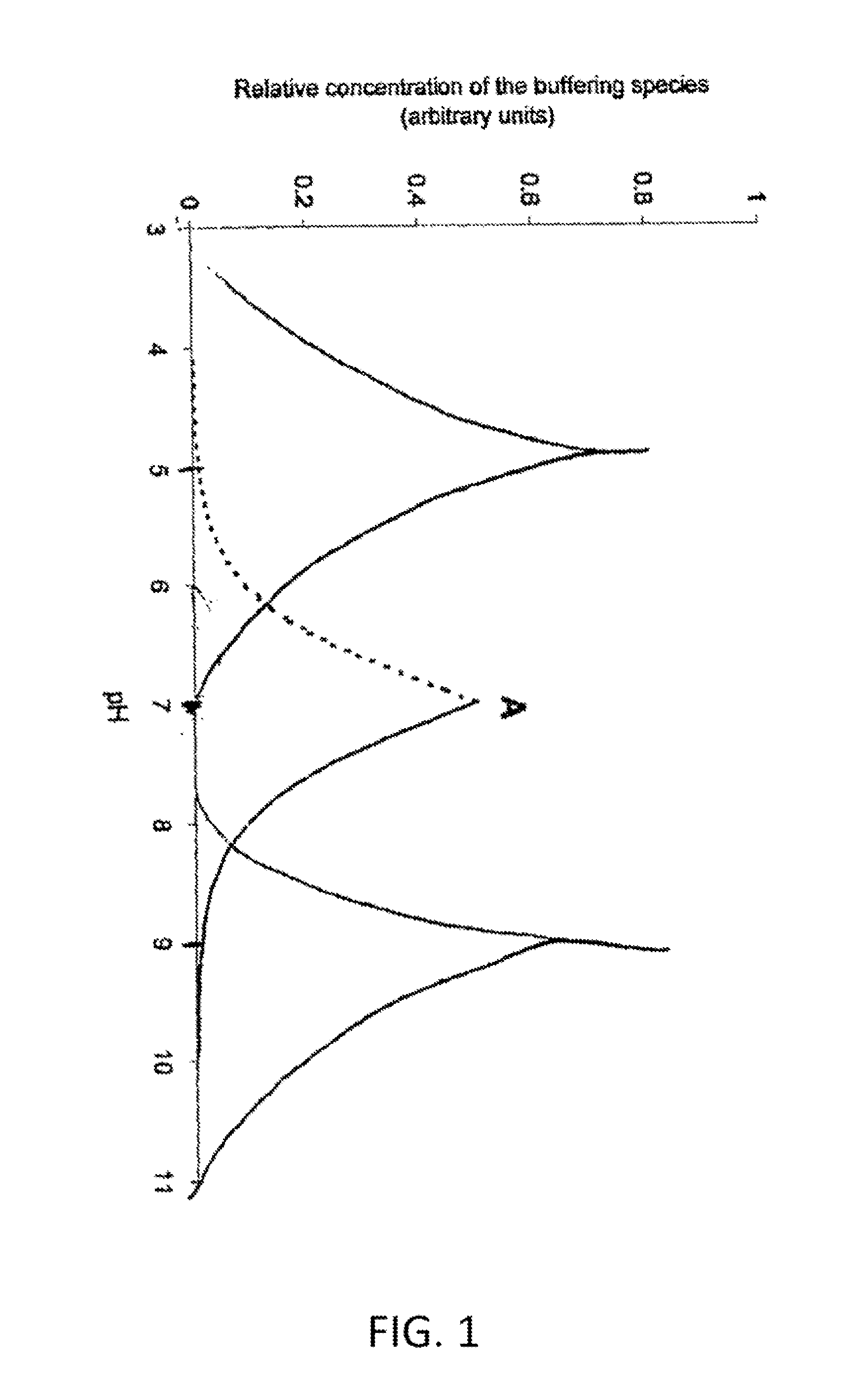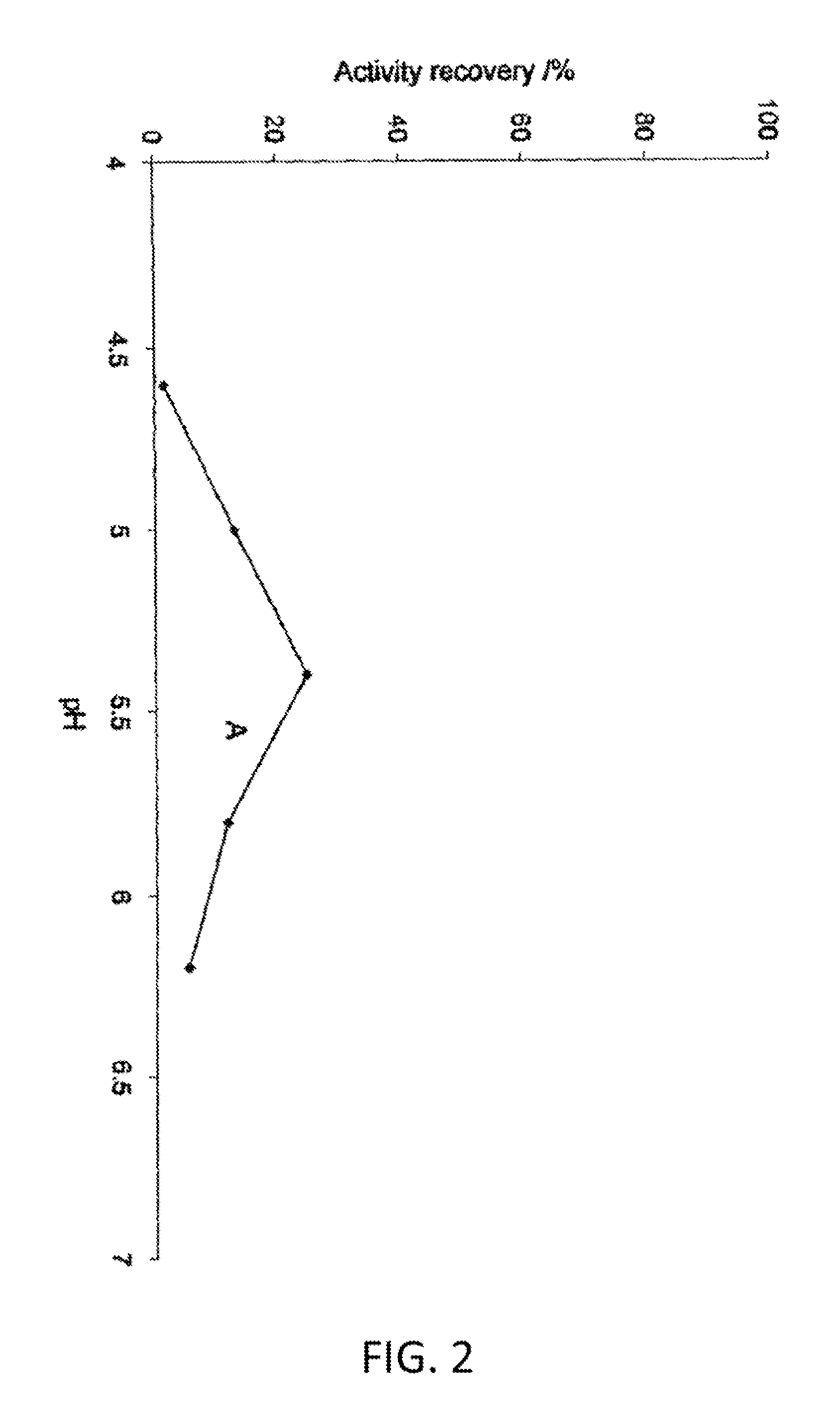Stabilization of Aqueous Compositions of Proteins with Displacement Buffers
a technology of displacement buffer and protein, applied in the field of stability of proteins in aqueous systems, can solve the problems of low stability, reduced production cost, and unstable antibodies or therapeutic proteins, and achieves the effects of reducing the production cos
- Summary
- Abstract
- Description
- Claims
- Application Information
AI Technical Summary
Benefits of technology
Problems solved by technology
Method used
Image
Examples
example 1
Glucose Oxidase (from Penicillium sp.) at 59° C.
[0235]Stability of glucose oxidase was tested in aqueous solutions at 350 μg mL−1 concentration. Stability was compared between solutions prepared both in the presence and in the absence of conventional buffers, and in the presence of displaced buffers. In each case the pH of the formulation was optimal with respect to stability of glucose oxidase in that particular formulation. The stability was compared in the following formulations:[0236]10 mM citrate (pH 5.4); prepared by mixing sodium citrate (10 mM) with citric acid (10 mM) to achieve the required pH; glucose oxidase was added to this formulation to achieve 350 μg mL−1 concentration, pH was checked after glucose oxidase addition and, if necessary, adjusted to 5.4 with either hydrochloric acid (5 M) or sodium hydroxide (5 M).[0237]10 mM nicotinate (pH 5.2); prepared by dissolving nicotinic acid (10 mM) in water and adjusting pH with sodium hydroxide (5 M); glucose oxidase was adde...
example 2
Glucose Oxidase (from Penicillium sp.) at 40° C.
[0244]Stability of glucose oxidase was tested in aqueous solutions at 350 μg mL−1 concentration. Stability was compared between solutions prepared both in the presence and in the absence of conventional buffers, and in the presence of displaced buffers. In each case the pH of the formulation was optimal with respect to stability of glucose oxidase in that particular formulation. The stability was compared in the following formulations:[0245]10 mM citrate (pH 5.2); prepared by mixing sodium citrate (10 mM) with citric acid (10 mM) to achieve the required pH; glucose oxidase was added to this formulation to achieve 350 μg mL−1 concentration, pH was checked after glucose oxidase addition and, if necessary, adjusted to 5.2 with either hydrochloric acid (5 M) or sodium hydroxide (5 M).[0246]200 mM citrate (pH 5.0); prepared by mixing sodium citrate (200 mM) with citric acid (200 mM) to achieve the required pH; glucose oxidase was added to t...
example 3
Catalase (from Bovine Liver) at 52° C.
[0258]Stability of catalase was tested in aqueous solutions at 100 μg mL−1 concentration. Stability was compared between solutions prepared both in the presence and in the absence of conventional buffers, and in the presence of displaced buffers. In each case the pH of the formulation was optimal with respect to stability of catalase in that particular formulation. The stability was compared in the following formulations:[0259]10 mM citrate (pH 6.4); prepared by mixing sodium citrate (10 mM) with citric acid (10 mM) to achieve the required pH; catalase was added to this formulation to achieve 100 g mL−1 concentration, pH was checked after catalase addition and, if necessary, adjusted to 6.4 with either hydrochloric acid (5 M) or sodium hydroxide (5 M).[0260]10 mM maleate (pH 6.5); prepared by dissolving sodium maleate (10 mM) in water and adjusting pH with hydrochloric acid (5 M); catalase was added to this formulation to achieve 100 μg mL−1 con...
PUM
| Property | Measurement | Unit |
|---|---|---|
| pKa | aaaaa | aaaaa |
| pKa | aaaaa | aaaaa |
| pKa | aaaaa | aaaaa |
Abstract
Description
Claims
Application Information
 Login to View More
Login to View More - R&D
- Intellectual Property
- Life Sciences
- Materials
- Tech Scout
- Unparalleled Data Quality
- Higher Quality Content
- 60% Fewer Hallucinations
Browse by: Latest US Patents, China's latest patents, Technical Efficacy Thesaurus, Application Domain, Technology Topic, Popular Technical Reports.
© 2025 PatSnap. All rights reserved.Legal|Privacy policy|Modern Slavery Act Transparency Statement|Sitemap|About US| Contact US: help@patsnap.com



